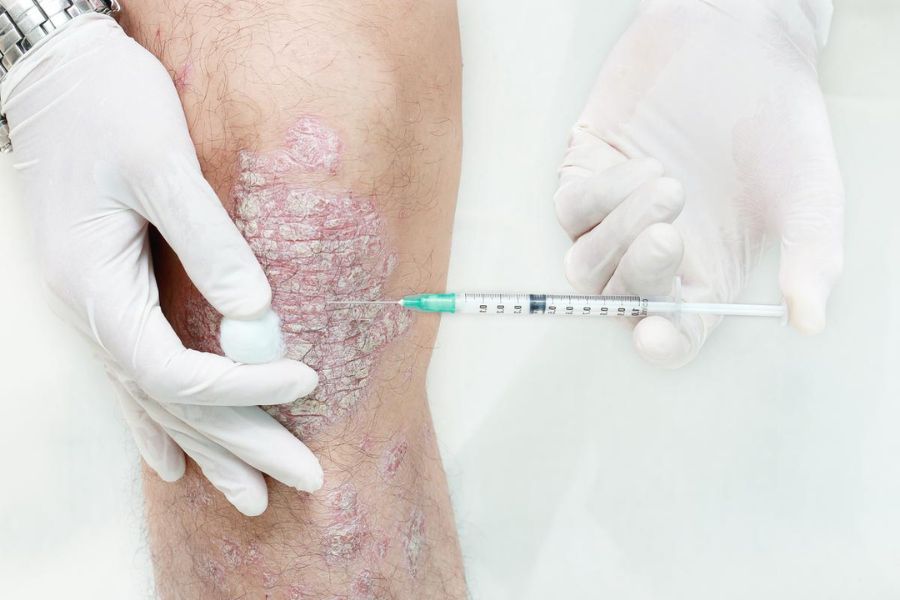
A question we sometimes get from panicked customers with armadillos in their yard is, “Do armadillos carry leprosy??!” The answer is “Yes,” wild armadillos are known carriers of leprosy, which is a chronic bacterial infection impacting the skin, nerves, and mucous membranes. The age-old disease, also known as Hansen's disease, can cause disfigurement, nerve damage, and disability if left untreated. While leprosy is rare in the United States, cases have been reported in areas where armadillos are common.
A research team at Colorado State University found that human contact with the nine banded armadillo can transmit leprosy. Leprosy has also been contracted when the victim ate nine banded armadillos themselves. The armadillo meat can carry the disease in its blood cells past its death.
The bacteria that causes leprosy, Mycobacterium leprae, can survive in the armadillo's body for years without causing symptoms. If you come in contact with armadillos, it is critical to take precautions, such as wearing gloves and washing hands thoroughly, to reduce the risk of infection.
Despite the potential risk, wild armadillos are not the only animals that can carry diseases. Other wild animals, such as rodents and ticks, can also transmit diseases to humans. It is important to know the health risks associated with wildlife and take necessary precautions to protect oneself.
Like most wildlife, armadillos can sometimes carry rabies, parasitic worms, or other bacterial infections. One of particular concern if you have pets is the bacteria salmonella. Armadillos can transmit salmonella to both cats and dogs.
As already mentioned, armadillos are infamous for carrying leprosy - partly because they are the only animals besides humans that carry the bacteria that causes leprosy. Below, we will discuss what leprosy is, how leprosy is transmitted, and general tips regarding the spread of leprosy.
Hansen's disease, which is much more commonly referred to as leprosy, is a chronic infectious disease caused by the bacterium Mycobacterium leprae. The disease impacts the skin, nerves, and mucous membranes of the upper respiratory tract. It is characterized by the formation of nodules, lesions, and deformities on the skin, as well as nerve damage that can lead to loss of sensation and muscle weakness.

Remarkably, untreated leprosy can take three to seven years before symptoms start to appear! Do not wait for painful skin lesions and damage to the skin and peripheral nerves to cause you to visit a doctor. Early diagnosis is important to minimizing damage.
Leprosy has been known since ancient times, and it has been associated with social stigma and discrimination in many cultures. Historically, leprosy was believed to be highly contagious and incurable, leading to the isolation and segregation of leprosy patients in leprosaria or "leper colonies." However, with the discovery of effective antibiotic treatments in the 20th century, leprosy is now considered a curable disease.
Despite this progress, leprosy remains a significant public health problem in some developing countries. According to the World Health Organization, there were 208,619 new cases of leprosy reported globally in 2021, with India, Brazil, and Indonesia having particularly large infected populations. According to the International Leprosy Association, approximately half of the leprosy cases worldwide are in southeast Asia.
Leprosy is usually transmitted via prolonged and close contact with an infected and untreated person or animal. It is not highly contagious and cannot be transmitted through casual contact or by touching objects that have been touched by an infected person. You can get leprosy from an armadillo by using and interacting with items in your yard that the armadillo may have infected.
The specifics of how leprosy is exactly transmitted is not yet fully understood. The most commonly believed transmission is through respiratory droplets or contact with infected nasal secretions. Armadillos have also been identified as a potential source of leprosy transmission in some cases, particularly in the southern United States where the animals are more common.

Overall, leprosy is a treatable and curable disease, but it remains a serious public health concern for millions of people globally. Understanding the causes and transmission of leprosy is an important step in preventing its spread and improving the lives of those affected by the disease.
Armadillos are small mammals native to the Americas. They are known for their tough, armored shells and their ability to dig burrows. There are 21 armadillo species, ranging in size from 5 to 59 inches. Armadillos are mostly nocturnal and are most active in warmer months. They feed on insects, worms, and other small invertebrates.
Armadillos can live in many different habitats, including prairielands, forests, grasslands, and deserts. They are excellent diggers and can create burrows up to 15 feet long. Armadillos are solitary animals and do not form social groups. One of their more unique features is that they can roll up into a ball, using their armor to protect themselves from predators.

Armadillos are one of the few animals that can contract leprosy, a chronic infectious disease that affects the skin and nerves. The bacteria that cause leprosy are slow-growing and can take years or even decades to produce symptoms. Armadillos are particularly susceptible to leprosy because their body temperature is slightly lower than that of humans, which allows the bacteria to thrive. Additionally, armadillos have a weak immune response to the bacteria, which makes them more susceptible to infection.
In conclusion, armadillos are interesting creatures that play an important role in their ecosystems. However, they can carry diseases such as leprosy, which can be transmitted to humans. It is wise to be cautious when handling armadillos or their habitats to avoid contracting any potential diseases.
Armadillos are known carriers of leprosy, a bacterial infection that can cause nerve damage, skin lesions, and other symptoms. It is believed that armadillos contract leprosy from other armadillos that are infected, and the bacteria can also be found in soil and water sources. Armadillos are particularly susceptible to leprosy because of their body temperature, which is lower than that of humans and other mammals. This makes it easier for the bacteria to thrive and spread throughout their bodies.
Several studies have shown that armadillos are a natural host for the bacteria that causes leprosy. One study conducted in Louisiana found that over 30% of armadillos tested positive for leprosy. Another study conducted in Texas found that armadillos were infected with the same strain of leprosy that is found in humans. These studies suggest that armadillos are a potential source of leprosy transmission to humans.
The risk of contracting leprosy from armadillos is relatively low, but it is still possible. People who come into contact with armadillos, either through hunting or handling them as pets, are at a higher risk of contracting the disease. The bacteria that causes leprosy can be found in the armadillo's skin, saliva, and feces, and can be transmitted through open wounds or cuts in the skin.
In conclusion, armadillos are known carriers of leprosy and can contract the disease from other infected armadillos or from soil and water sources. Human transmission is rare, but it is still possible, particularly for those who come into close contact with armadillos. It is important to take precautions when handling armadillos, such as wearing gloves and avoiding contact with their saliva and feces, to minimize the risk of contracting leprosy.
Several cases of human leprosy have been documented as being caused by exposure to armadillos. In a study conducted in Louisiana, researchers found that 25% of leprosy cases in the state were linked to exposure to armadillos. In another study, researchers found that 62% of the leprosy cases in a particular area of Brazil were linked to exposure to armadillos.
Studies have found armadillos to carry the same strain of leprosy that impact humans. In fact, scientists say the strain of leprosy found in armadillos is very similar to the strain found in humans. This suggests that armadillos may be a source of leprosy infection for humans.
Armadillos are native to the Americas, and the majority of documented human cases of leprosy from armadillos have occurred in the southern United States and in Central and South America. In the United States, Texas, Louisiana, and Florida have the highest number of cases reported.
Even in these states, while armadillos can carry leprosy, the risk of contracting the disease from an armadillo is very low. It is important to note that while armadillos can carry leprosy, the risk of contracting the disease from an armadillo is very low. Most people who come into contact with armadillos do not develop leprosy. However, it is still important to take precautions when handling armadillos or coming into contact with their bodily fluids.
Leprosy is a rare disease, and the risk of contracting it from armadillos is low. According to the Centers for Disease Control and Prevention (CDC), most people who are exposed to armadillos with leprosy do not contract the disease. However, is it worth taking the risk and letting an armadillo roam your yard freely? Probably not.

People who are at higher risk of contracting leprosy from armadillos include those who:
To reduce the increased risk of of contracting leprosy from armadillos, people should take the following preventative measures:
While armadillos can carry leprosy, the risk of contracting the disease from them is low. By taking preventative measures, people can reduce their risk of transmission and protect themselves from this rare but serious disease.
In conclusion, it is clear that armadillos can carry leprosy and are a potential source of transmission for this disease. The bacteria that cause leprosy are transmitted through contact with the bodily fluids of infected individuals, including armadillos.
It has been observed that armadillos living in endemic countries where leprosy is more relevant are more likely to carry the bacteria that cause the disease. However, again, not all armadillos carry leprosy, and the risk of transmission from armadillos to humans is relatively low in other countries.
Despite the low risk of transmission from armadillos to humans, it is still important to take preventative measures to minimize the risk of contracting leprosy. This includes avoiding contact with armadillos, especially those that are sick or dead, and wearing protective clothing when handling armadillos or their bodily fluids.
It is also important to seek medical attention if you suspect that you may have been exposed to leprosy, as early treatment can help prevent serious complications and reduce the risk of transmission to others. You can learn more about symptoms, treatment, and preventative measures at the National Hansen's Disease Program website.
Overall, while armadillos are a potential source of transmission for leprosy, the risk of contracting the disease from these animals is relatively low. By taking appropriate preventative measures, individuals can minimize their risk of exposure and protect themselves from this potentially serious disease.
If you are in need of armadillo trapping services, calling a wildlife removal expert can save you a lot of time and effort. Trapping armadillos is very difficult. At Critter Stop, we have helped countless customers with their armadillo removal needs, and it can still take us many weeks to get the problem totally resolved.
If you live in the Dallas - Fort Worth Metroplex and have armadillos tearing up your yard, give Critter Stop a call to see how we can help, our number is (214) 234-2616.
Visit our Critter Library and learn more about our furry friends







